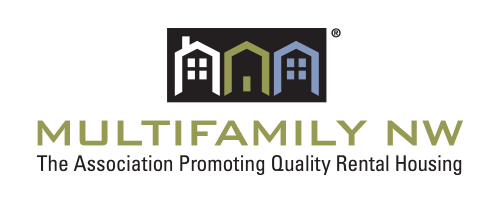June 2021 Monthly Rent Survey Results
 Multifamily NW collaborated with a broad group of housing professionals (management companies, private managers, housing authorities, nonprofits, and state agencies) to collect surveys of conventional and affordable rental housing to track trends in ability to pay rent in occupied units across Oregon.
Multifamily NW collaborated with a broad group of housing professionals (management companies, private managers, housing authorities, nonprofits, and state agencies) to collect surveys of conventional and affordable rental housing to track trends in ability to pay rent in occupied units across Oregon.
Key findings for June:
- On average, 12% of Oregon households did not pay their rent by the 15th of the month, which represents a significant improvement from 13.2% in May.
- Statewide, conventional housing showed moderate improvement between May and June, improving from 13.4% to 11.9% nonpayment. Improvements of 2-3% were recorded uniformly across each housing type. Various reasons were suggested: Households returning to work, some rental assistance being received at the properties, and elective non-payers beginning to return to their regular schedule of payments.
- In the statewide sample of Affordable Tax Credit units, 13.5% were unable to pay rent, a 1% decline when compared to the average of 12.5% the previous month.
- Conventional Class-C workforce multifamily housing continued to experience the most serious housing insecurity with a 15.5% inability to pay rent. Renters in this housing type have consistently been the most impacted by inability to pay throughout the pandemic. NOTE: The much higher vacancy average in this asset class appears to reflect an entry error in the Portland Data set. We believe vacancy is below 3% across the state in Class-C workforce housing.
- Nine or Fewer Units - We received responses representing 140 units from owners with nine or fewer units, compared to 97 last month. This sample showed 18.9% inability to pay, compared to 14.8% last month. There is high variability in this cohort each month, with a different group of owners electing to respond. However, each month we receive consistent messages that owners of this asset class have made the decision to sell some or all of their units.
Note on Methodology:
The survey asks: “How many occupied households were unable to pay full rent by the 15th day of the month?” The survey then adjusts for vacancy to arrive at the true percentage of occupied households that are unable to pay their full rent.
Definitions
Real estate professionals often use categories (A, B, or C) to describe rental properties after considering a combination of factors such as age of the property, location of the property, growth prospects, appreciation, amenities, and rental income. There is no uniform or precise formula for establishing these categories.
Class A - These properties represent the highest quality buildings in their market and area. They are generally newer properties built within the last 15 years with top amenities and demand the highest rent with little or no deferred maintenance issues.
Class B - These properties are close to Class A designation being generally older and typically offer fewer amenities. Rent is typically lower than Class A
Class C - Class C properties are typically more than 20 years old and are not as well located. Due to a variety of factors, Class C buildings tend to have the lowest rent rates in the Conventional Housing market when compared to Class A and B properties.
Conventional Housing – Market-rate housing with no household income limits, rent limits, or special programmatic requirements in the financing.
Affordable Housing – Government financed housing (Often using Tax Credits or Bonds) that impose initial household income limits and maximum rent limits, all predicated on affordability calculations based on the area median income.
Additional Survey Comments:
- "The state of Oregon needs to create a risk management insurance pool (similar to SAIF) for Landlords. The state has changed the business environment with uninsurable risks … they need to provide an insurance option. All the legislated issues are not covered by our conventional insurance providers. The state is making rules that they need to provide an insurance option for Landlords to use to manage their risks."
- "I’ve been personally reaching out to tenants in arrears. I start by asking how they are doing. I then give them updates on our successful LLCF applications on their behalf. Lastly I make it clear this is NOT an attempt to collect a debt but I’m blunt...you’ve got a balance and soon rent will be due an expected to be paid. Do you have a plan for paying rent when it becomes due? "
- "I believe most of my delinquent balances are elective non-payers. Potentially as much as 70% of the delinquent homes."
- "I think there needs to be a 3rd party to verify that the tenants truly can’t pay their rent. If there is a true financial hardship, those are the ones that are actively seeking rental assistance each month. Where is the program to hold the tenant liable for not telling the truth?"
- "We have seen the trend month after month, everyone has gotten relaxed and are not worried about paying on time. We see 6-9% delinquent at the beginning of the month, 2.4-3.0% del at the end of the month. There are less than 1% of residents that owe more than 2 months of past due rent."
- "Our one rental which is delinquent on their rent has been delinquent for a full year now and we are selling this property."
- "Another great example – we have approved an application for one of our units, the approved applicant actually said 'I have the money to pay rent after I have moved in, however, there is free money from agencies for up to one year of them paying my rent. So why not take advantage of the free money that the government is handing out?'”
